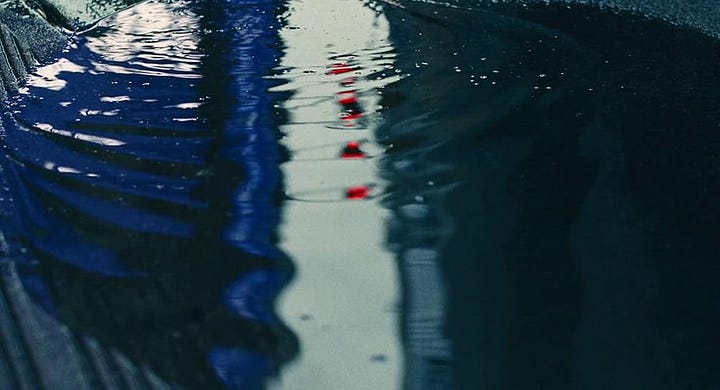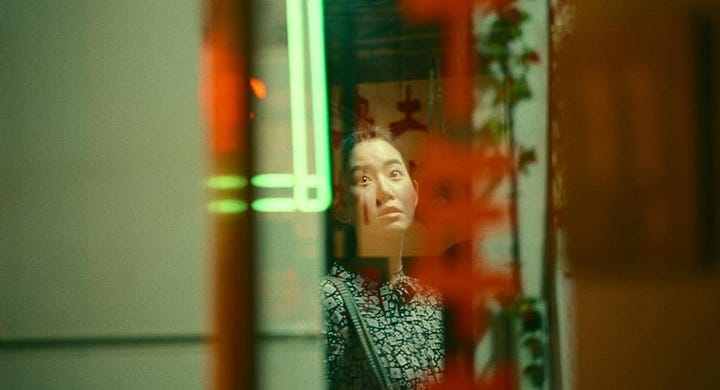The cinematic function of the mirror
For now, two main functions of reflective surfaces in filmmaking
Mirror, mirror on the wall, you offer great depth to cinema. This brief essay is an ode to reflective surfaces — mirrors, water, windows, or anything else whose shine can project light with clarity — and how they can emphasize cinematographic dimensions. There are two main functions that such surfaces can take on in a film.
The most obvious function pertains to thematic development. Mirrors can be symbols of psychological reflection, used when characters “reflect” on the self, on unspoken motifs, on the events within the story, etc. Many shots come to mind, especially the over-the-shoulder shot of someone looking at themselves in the mirror, but these are often guaranteed in a film which tackles introspection or decline.
The second function is far more fascinating. Reflective surfaces can be used to expand cinematic dimensions, offering angles, specters and projections to not only increase compositional value, but also to reach into the untapped regions of the camera’s extra-spatial dimensions.
Function I: Reflection as a Theme
Although the most common use of reflective surfaces, there are more profound applications of “reflections,” from surrealism to the formalist montage masters of the Soviet Union.
Above is a very known example in the experimental underground. Maya Deren’s Meshes of the Afternoon is centered around this elusive figure whose face is no more than a looking glass, possibly an attempt to build an entity whose likeness would take on an uncanny replicant of its beholder. Unlike the typical mirror shot, we have the mirror itself becoming a symbol of reflection — who would have thought? Yet Deren’s mirror is not stationary — it has limbs and moves like a human, suggesting that the idea of reflection is as fleeting and fickle as the beholder of the shiny profile. What does this say about introspection? Possibly that the image of “self” is arbitrary and has a will of its own. By replacing the face with a mirror, Deren took the object and turned it into a personified symbol, a subversion of the usual function of the mirror as a basic means of reflection within a film. The over-the-shoulder mirror shot is common to films like Joker, Nightcrawler or Black Swan (the third of which I will discuss in a moment) — these films all depict psychological decline, making the perception of “self” an important central theme. However, Deren presented something different.
Deren’s most acclaimed work was an early example of reflective surfaces serving as a thematic thread, only this was one of the first personifications of the object. Mirrors have served as important motifs in previous movements as well. Consider the brief clips below, both coming from Soviet montage filmmakers of the 1920s, who used water’s reflective potential to create symbolic statements of disruption.
Sergei Eisenstein’s Strike is centered around factory workers who strike against their bourgeois managers. Near the beginning of the film, this shot shows a reflection of the factory in a puddle of water. When the man standing in the puddle walks away, it causes a ripple, implying that this institution — the factory — will shake. “Trouble is brewing,” says one worker to another before this image unfolds. Indeed, this factory will never be the same.
Below is the second clip, from Lev Kuleshov’s By the Law. Contrary to Eisenstein and other Soviet filmmakers at the time, there were no overt political themes in Kuleshov’s film. A chamber thriller about a group of prospectors, the film showed the psychological decline of the characters as they froze and starved in the tundra, taking away mere slivers of gold. Once again, we return to the idea that reflections reveal psychological themes, only it can be related to the same shot in Strike, since the rippling effect of the water once again implies that something will stir, only this time pertaining to a specific character instead of an institution.
Below are more shots that express psychological change through reflections.
In Juraj Herz’s The Cremator, this shot comes at the very start. When compared to the state of the cremator’s family at the end of the film, this image becomes harrowingly cold. Like a fisheye lens, the mirror at the zoo slightly distorts the family, likely to foreshadow their undoing by presenting them as starting to “warp.” Instead of the individual, the entire family is the subject of this reflective distortion.
This shot from Celine Song’s Past Lives is a reflection of a character in his hotel room window. Thematically, this shot’s strength lies in the romance that this character never explored, and as he visits her in New York, he is disembodied in his solitude. To express his disembodiment, Song opted to show his reflection in the mirror, causing a blur between him and the metropolis beyond the glass.
In Past Lives, reflective surfaces also served as compositional reinforcers, often distorting faces and settings. This is a common technique, especially in contemporary art-house cinema. However, these shots are still relevant to this specific film’s cinematic language, as it describes the union between characters and setting as light and reflective surfaces break them down into thematic mosaics of expression.


Finally, there is Darren Aronofsky’s Black Swan, a film whose use of reflective surfaces is melded to the very core of its visual language. As a film about image and performance, the self becomes important to its thematic palette, and the act of looking oneself in the mirror is an important act throughout the film.
However, the beauty of this film is that Aronofsky’s use of reflective surfaces became integral to the film’s formal qualities, and the film therefore embodied both functions of reflective surfaces that are mentioned in this essay.
Function II: Expanding Cinematic Dimensions
If film shows the synthesis of space and time, then mirrors have a role to play. While the camera is stationary, objects can move in and out of the frame but still be shown in mirrors, windows or screens within the shot’s composition. Black Swan is an excellent example for various reasons. Not only were there mirrors in the protagonist’s home and dressing room, the film being set in a ballet studio offered a massive mirror to be utilized by Aronofsky and Matthew Libatique, the film’s cinematographer. The shot below is an excellent example.
This is a simple yet effective shot. The camera is pointed at the protagonist and the mirror in front of her, but the mirror allows us to see another character approaching from behind. This simple trick is not just structurally fundamental; it is a creative utilization of mirrors to reinforce composition, for only with the mirror can we have two protagonists in the shot, creating balance, filling the frame through cinematic hedonism and excess.
However, like the previous function, there are many other ways reflective surfaces can expand cinematic dimensions. One of my favorite examples from the past few years is Charlotte Wells’ Aftersun, a film which uses a plethora of reflective surfaces — from television screens to mirrors — to show characters moving around a room without moving the camera an inch. Unfortunately, I could not procure examples, but that just means you’ll have to watch it yourself — trust me, it’s worth it.
Instead, here’s an example from one of Marguerite Duras’ early films, Destroy, She Said. A long take shows two characters conversing seemingly across a room, separated by a waist-high barrier. However, this turns out to be an illusion once the camera moves. See the brief clip below.1
In this film and many others, shots are revealed to be reflections in a mirror, which adds layers to the unreality of dialogue, of relationships, of interactions, of characters. If there is one thing that is common across all of these examples, it’s that a reflective surface and the images they mimic are not real; they are disembodied and artificial, isolated from the rest of the “reality” of a setting by the biased eye of the cinematographer. They can become metaphors through juxtaposition, integral to the visual language of cinema since the foundations of filmic art.
But one of the greatest users of reflective surfaces was the great Jacques Tati, whose fusion of cinematic systems and slapstick comedy produced less laughs and more pure ecstatic pleasure. The clip below is perhaps one of the greatest uses of reflective surfaces in cinematic history. Tati, playing his usual character of M. Hulot, attempts to catch the attention of the man carrying the blue folder. Believing that the man is across an alleyway, his only failure was his failure to look to his left.
This was not the only time Tati used reflections to create new worlds in Playtime, but I will leave you to discover these beautiful moments on your own. His blending of practical cinematic tricks and humble comedy turned Tati’s films into serene, joyous celebrations of warmth, humanity and cinema itself.
In other examples, reflections simply add depth to cinematographic composition, from the reflections of trees on the Amazon River in Werner Herzog’s Fitzcarraldo to the windows and mirrors occasionally gracing the shots in Steven Soderbergh’s Black Bag, to the brutality and disconnection of Shinji Somai’s Love Hotel. Once again, however, I must return to Black Swan before concluding this brief article, with one of the greatest mirror-reinforced compositions in contemporary cinema.
Just look at all of the mirrors contained in this chaotic shot. The compositional integrity of the shot could be debated, but the fact of the matter is this: Mirrors were used very strategically here and throughout the entire film not only as a symbol but as an aesthetic measure. It is not until one sees the mirror in the bottom left that one realizes the majority of the shot is indeed a mirror, the small looking glass on the right simply a component of the vanity in her dressing room. Then, the rear of the mirror on the bottom left provides a reflection of nothing, merely adding geometric depth to the rest of the composition. Thus, it is reveals the importance of circles throughout the entire shot — circles which traditionally tell us to focus on something but refuse to do so here. Like the other fragmented reflections throughout the film — and there are many, many others — they not only show compositional strength but depict a shattered psyche.
I just realized you can see my mouse in most of these clips, but whatever. They’re there for reference, so you get what you get.








Goddard’s opening in Vivre sa vie is another great example. Many more in that film.